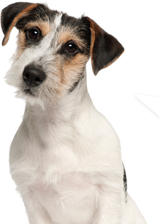How to Reduce Jumping
When dogs jump up on people, it can be more than a nuisance behavior, it can be dangerous. Large dogs can knock people down, causing injury, especially in children and the elderly. Many puppies learn at a young age that jumping on humans is acceptable. However, when the dog gets older, they will continue to jump on people. If you can, start teaching them to keep all four paws on the floor during puppyhood. However, if your adult dog jumps on you or guests, have no fear; it is still possible to change that behavior!
Think of teaching “four on the floor” as a basic exercise. Before your dog begins jumping, reward them with a tasty treat. Pay close attention to where you are placing your treat hand. If you raise your hand too high, you will accidentally encourage your dog to jump. The treat should be delivered at the dog’s lower jaw or tossed on the floor. .jpg)
Understanding how dogs learn and what motivates their behavior is key. Often people respond to a jumping dog with verbal attention, petting, or even rough pushing. For most dogs, this is reinforcing the behavior. The dog thinks that jumping earns them what they want: your attention! We want to teach our dogs they can get our attention, treats, and petting when they have four paws on the floor. If they jump, they lose access to these rewards.
Teaching Four on the Floor
When your dog jumps on you, cross your arms and turn your body away from them. When they have four feet on the floor, reward them with petting, attention, and/or treats. Treats should be something your dog considers high-value, like boiled chicken or hot dogs. These treats should be cut into pea-sized pieces so your dog does not consume too much. Over time, your dog will learn that jumping does not get them what they want. It is important for everyone in the household, including visitors, to consistently ignore the jumping and reward them whenever they are keeping all four paws on the floor. If your dog continues to jump on you even when you ignore them and becomes increasingly excited, remove yourself from the situation. Leave your dog alone for 30 seconds to a minute and try again. You may have to repeat removing yourself a few times. See Inappropriate Play Handout and/or Mouthing Handout.
Teach Your Dog to Sit for Greetings
It is helpful to teach your dog to sit for all greetings and interactions. You can teach your dog that sitting is extremely rewarding by giving them treats, playtime, or other valuable resources. By reinforcing “sit” with treats, attention, or other rewards, your dog will learn to do it as an automatic response when greeting and interacting with you, rather than jumping up to say hello.
Practice When Guests Come Over
Set your dog up for success by managing interactions with people. If you are having guests over, give them an enrichment item and keep them in a crate or in another room behind a baby gate until the excitement of the guest’s arrival has passed. You can also keep them on a leash and reinforce sitting while the guest approaches and offers attention if they desire. Tell your guests what you are working on. Have them practice by rewarding the dog with treats and giving attention when your dog is sitting or has four on the floor. Ideally, everyone your dog encounters should be consistent with this training.
Other Management Tips
Keep treats in a garage, car, or main entry way and toss multiple treats on the ground as you enter. When you and your dog are out and about, always have treats on-hand. If your dog becomes excited and starts to jump, toss treats on the ground to keep the dog’s focus on eating the treats and not jumping. This can be a great distraction for your dog if a surprise situation arises and causes excitement.
Keep your arrival home low-key. If your dog is crate trained or in a separate area of the home, do not rush in to greet them enthusiastically. Instead, calmly acknowledge them and take a few minutes to bring in your bag, read the mail, etc. Even if it has been a long day, keep your energy low and take your dog outside to relieve themselves. The more you practice these tips, the quicker your dog will learn that your arrival home is not that exciting.
Provide your dog with plenty of physical exercise. When your dog has expelled energy constructively, perhaps by playing a strenuous game of fetch, they will be more relaxed and comfortable.
Provide your dog with mental enrichment items. Give your dog a stuffed Kong, treat, meal dispensing toy, and plenty of appropriate items to keep their brain busy and relieve stress. Have your dog’s favorite enrichment item ready when guests visit. (See exercise and enrichment handout).
Take your dog to Manners Classes. The Wisconsin Humane Society offers a variety of classes.
